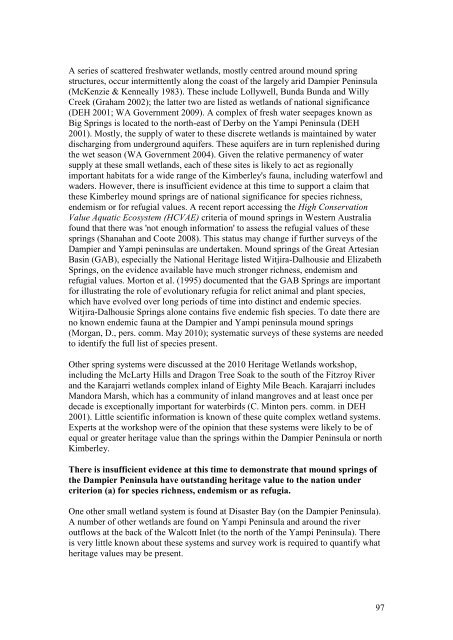WEST KIMBERLEY PLACE REPORT - Department of Sustainability ...
WEST KIMBERLEY PLACE REPORT - Department of Sustainability ...
WEST KIMBERLEY PLACE REPORT - Department of Sustainability ...
You also want an ePaper? Increase the reach of your titles
YUMPU automatically turns print PDFs into web optimized ePapers that Google loves.
A series <strong>of</strong> scattered freshwater wetlands, mostly centred around mound spring<br />
structures, occur intermittently along the coast <strong>of</strong> the largely arid Dampier Peninsula<br />
(McKenzie & Kenneally 1983). These include Lollywell, Bunda Bunda and Willy<br />
Creek (Graham 2002); the latter two are listed as wetlands <strong>of</strong> national significance<br />
(DEH 2001; WA Government 2009). A complex <strong>of</strong> fresh water seepages known as<br />
Big Springs is located to the north-east <strong>of</strong> Derby on the Yampi Peninsula (DEH<br />
2001). Mostly, the supply <strong>of</strong> water to these discrete wetlands is maintained by water<br />
discharging from underground aquifers. These aquifers are in turn replenished during<br />
the wet season (WA Government 2004). Given the relative permanency <strong>of</strong> water<br />
supply at these small wetlands, each <strong>of</strong> these sites is likely to act as regionally<br />
important habitats for a wide range <strong>of</strong> the Kimberley's fauna, including waterfowl and<br />
waders. However, there is insufficient evidence at this time to support a claim that<br />
these Kimberley mound springs are <strong>of</strong> national significance for species richness,<br />
endemism or for refugial values. A recent report accessing the High Conservation<br />
Value Aquatic Ecosystem (HCVAE) criteria <strong>of</strong> mound springs in Western Australia<br />
found that there was 'not enough information' to assess the refugial values <strong>of</strong> these<br />
springs (Shanahan and Coote 2008). This status may change if further surveys <strong>of</strong> the<br />
Dampier and Yampi peninsulas are undertaken. Mound springs <strong>of</strong> the Great Artesian<br />
Basin (GAB), especially the National Heritage listed Witjira-Dalhousie and Elizabeth<br />
Springs, on the evidence available have much stronger richness, endemism and<br />
refugial values. Morton et al. (1995) documented that the GAB Springs are important<br />
for illustrating the role <strong>of</strong> evolutionary refugia for relict animal and plant species,<br />
which have evolved over long periods <strong>of</strong> time into distinct and endemic species.<br />
Witjira-Dalhousie Springs alone contains five endemic fish species. To date there are<br />
no known endemic fauna at the Dampier and Yampi peninsula mound springs<br />
(Morgan, D., pers. comm. May 2010); systematic surveys <strong>of</strong> these systems are needed<br />
to identify the full list <strong>of</strong> species present.<br />
Other spring systems were discussed at the 2010 Heritage Wetlands workshop,<br />
including the McLarty Hills and Dragon Tree Soak to the south <strong>of</strong> the Fitzroy River<br />
and the Karajarri wetlands complex inland <strong>of</strong> Eighty Mile Beach. Karajarri includes<br />
Mandora Marsh, which has a community <strong>of</strong> inland mangroves and at least once per<br />
decade is exceptionally important for waterbirds (C. Minton pers. comm. in DEH<br />
2001). Little scientific information is known <strong>of</strong> these quite complex wetland systems.<br />
Experts at the workshop were <strong>of</strong> the opinion that these systems were likely to be <strong>of</strong><br />
equal or greater heritage value than the springs within the Dampier Peninsula or north<br />
Kimberley.<br />
There is insufficient evidence at this time to demonstrate that mound springs <strong>of</strong><br />
the Dampier Peninsula have outstanding heritage value to the nation under<br />
criterion (a) for species richness, endemism or as refugia.<br />
One other small wetland system is found at Disaster Bay (on the Dampier Peninsula).<br />
A number <strong>of</strong> other wetlands are found on Yampi Peninsula and around the river<br />
outflows at the back <strong>of</strong> the Walcott Inlet (to the north <strong>of</strong> the Yampi Peninsula). There<br />
is very little known about these systems and survey work is required to quantify what<br />
heritage values may be present.<br />
97
















